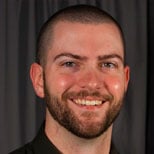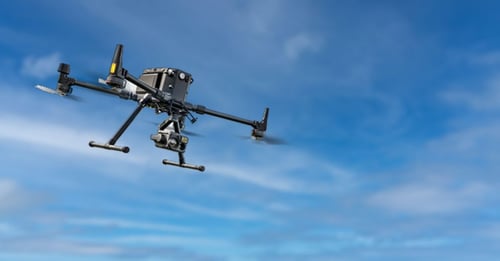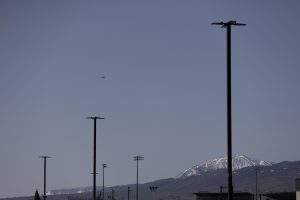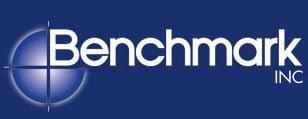
Ben Fiedler
Staff Consultant and Chief Drone Pilot
Benchmark has been using drone technology—more formally known as Unmanned Aerial Vehicles (UAVs)—for several years.
The benefits of UAVs in commercial roofing are plentiful. They reduce the need for on-the-roof infrared surveys, which decreases risk and saves time and money. The technology allows for a close-up view of areas that may not be accessible on foot. Additionally, the detailed measurements are created faster than a traditional investigation and are also more accurate.
While UAVs are quickly becoming commonplace in the roofing industry, Benchmark’s commitment to clients’ needs means that our UAV services and expertise go one step further.
Below, Staff Consultant and Chief Drone Pilot Ben Fiedler answers some of the most frequently asked questions about UAV technology at Benchmark and explains how it benefits Benchmark’s clients.
Q: How long has Benchmark used UAV technology?
We’ve been using drones since 2014, however until 2021, we have subcontracted the flying of the drone to companies that offer the service.
While that process worked, we realized we could do better. Since we’re experts in roofing, we know the best times to fly to inspect a roof, what to look for when flying, etc. We invested in our own equipment and in having certified drone pilots on staff. We don’t just have drone pilots at Benchmark, we have knowledgeable and experienced roof consultants that fly drones to collect the information they need.
Q: Can you share an example of a situation where having an experienced roof consultant as the drone pilot made a difference for the client?

UAVs reduce the need for on-the-roof infrared surveys, which decreases risk and saves time and money.
Prior to having our own UAV, we had a project where we were to complete an infrared scan of the roof, then planned to go up on the roof the next day to verify the suspected wet insulation.
The data we received from the drone contractor’s flyover was confusing. The infrared signature was atypical for that type of construction. The building had Thermoplastic Polyolefin (TPO), then another layer of membrane had been installed directly over the first about 10-15 years later. This is unusual; typically, a layer of insulation is installed over the existing roof before a new membrane.
Due to this construction, the infrared signature looked odd. When I reviewed the data, I questioned the results. So, I cut core samples and was able to verify what I was seeing.
In short, a drone pilot without roofing experience doesn’t have the technical expertise to identify areas of importance during a flyover and to properly interpret the data.
Q: Why is drone technology more accurate than traditional infrared moisture survey techniques?
One example is a client that we have completed three surveys for over the years. Our process has improved thanks to the use of UAV technology.
On our initial investigation, we performed an infrared survey exclusively using a handheld infrared camera. It took two teams four nights to complete the survey. The process required using the handheld camera and walking the roof back and forth, searching for wet areas. Another team member then used a laser pointer built into the handheld camera to identify the area, and the other marked the area using paint. The next day, we came back to measure those spots to quantify the wet areas. This method is time consuming and can be risky with regard to consultant safety.
For the second survey, we hired a third-party company to complete the infrared moisture scan with a drone. They then sent us their proposed areas that they suspected were wet. We reviewed their images it and we disagreed. We ended up scanning the entire facility by handheld again to verify the findings.
On the third survey, we self-performed the drone-based infrared survey with our own equipment. It took a total of two hours to scan the entire site. Our consultants in the field then had the infrared results to verify as they were completing the survey.
Lastly, rather than the survey team marking areas on a hard copy of the drawing which our drafting team must then transcribe, the orthomosaic is brought right into AutoCAD and traced. This results in a much more accurate quantification of wet insulation. The overall time savings and the improvement in drafting accuracy is enormous.
Q: UAV technology is obviously a huge benefit for roofing, but what about pavement? Can it help facilities managers with their pavement asset management?

A UAV can provide measurements that are more detailed and accurate than a traditional investigation can produce.
Opportunities in the paving industry are growing, and we are excited to expand our use of UAV technology for surfaces other than roofing. One example is a client that has a three-mile-long facility. In the past, we have done traditional topographic surveys with sophisticated single-person X, Y and Z data collection equipment (Auto Tracking Total Station) which took us three days to survey less than 1/3 of the lots and roadways at this facility.
Using a drone, we were able to capture the entire three-mile stretch in three hours, resulting in significant time and cost savings while maintaining accuracy.
An additional way we have used drone technology in pavement management is through capturing an orthomosaic by using both the infrared camera and the RGB camera built into the drone, which can reveal issues of uneven light coverage in parking areas.
One client was in the midst of a pavement project and had to remove a light pole in order to reroute traffic. Their lighting map revealed that the area was already over-lit, so the client was able to save money by not replacing it once the project was complete.
Q: How are UAVs being used for BIM (building information modeling) at Benchmark?
One of the many uses is the creation of RGB orthomosaic. An orthomosaic is basically one large photo of an entire site, that includes geospatial data. We import the file into AutoCAD and run a command, which will then rotate it, scale it, and position it in real space.
The benefit of an RGB orthomosaic is that it is in AutoCAD exactly to scale of reality. Our drafters can then trace all the penetrations and perimeters, all within a three-inch accuracy with of the physical building.
Historically, we would use either Pictometry or Google Earth for this data. The disadvantage of these services is that they create an oblique image since it is taken from an airplane flying by, or from a satellite with lower resolution. Because of the angle of the camera, there is perspective skew. That means the building’s dimensions may be spot on in the front but could be 10-feet off at the opposite end of the building, due to the perspective of the photo. By having the drone generated orthomosaic, we are able to draw these sites for the first time exactly as they exist in the real world.
